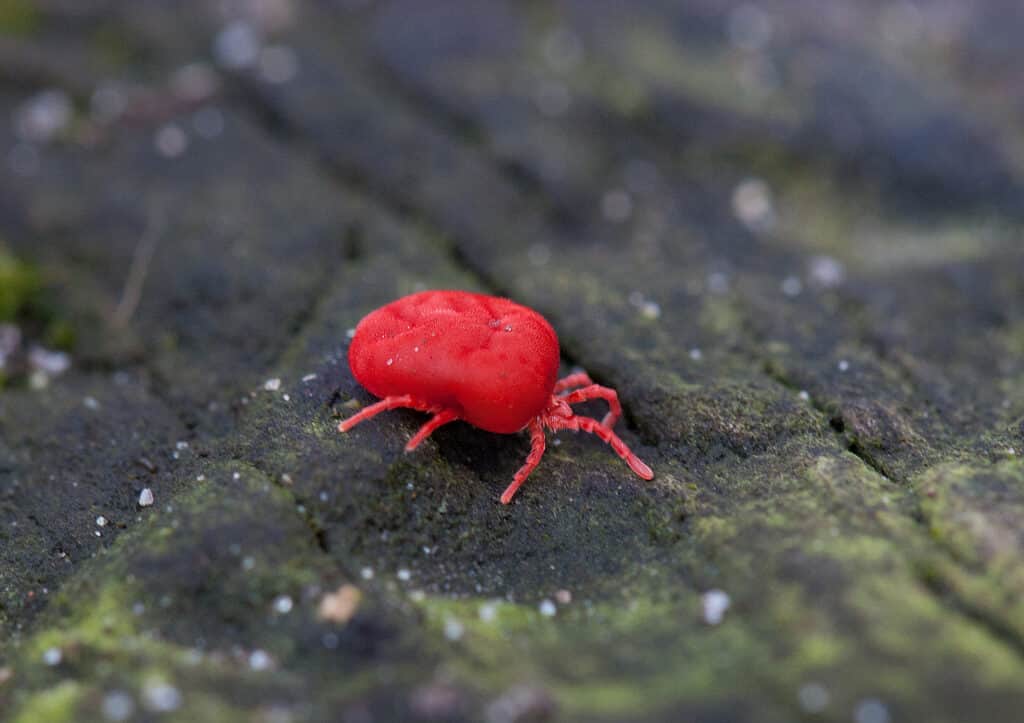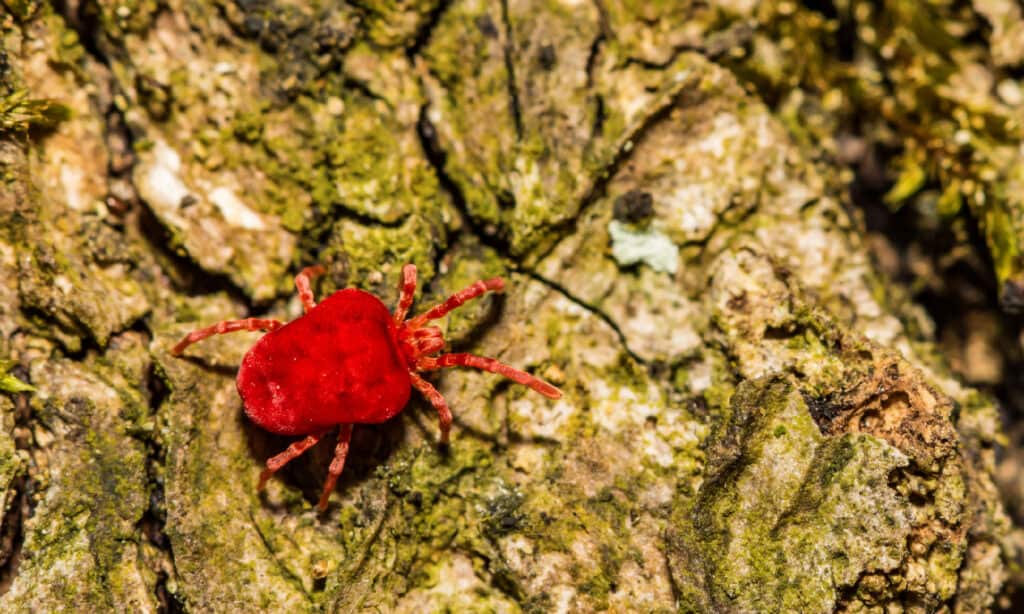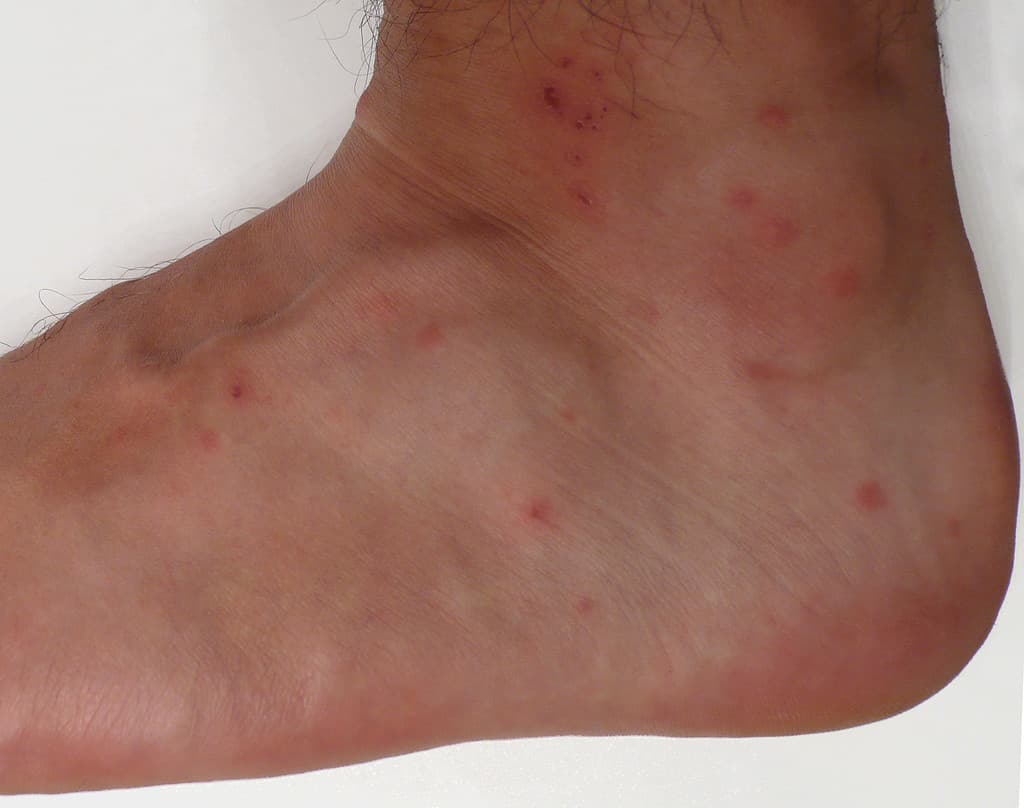You might walk in the park with your kids or spend an afternoon on the golf course. But that outdoor fun sometimes comes with a price: an itchy rash caused by bugs you can’t see. They are called chiggers, so small you need a magnifying glass to see them.
They aren’t dangerous, but their bites can urge you to scratch. Learn everything you need to know about chigger bites, including their appearance, where they are found, why they bite humans, and prevention and treatment options.
What Are Chiggers?
Chiggers, also known as Trombiculidae, are mites related to spiders and ticks. Henry Ellsworth Ewing named the family Trombiculidae, which means “to shake” in Greek. Trombiculid mites were spotted for the first time in North America in 1733.
Appearance
Chiggers are small insects roughly 1/150 of an inch long, so you’d need a magnifying lens to see them. They are red and can only be seen in groups or clusters because of their small size.
A juvenile chigger has six legs, but an adult mite has eight. Chiggers are typically red, but they will become yellow if fed a blood-based diet. An adult chigger may grow 3/10 of an inch long, making it visible to the naked eye.

©Matauw/Shutterstock.com
Chiggers Life Cycle
Chiggers undergo four phases of transformation throughout their lifetime: egg, larva, nymph, and adult. Adult chigger mites deposit their eggs in damp places such as leaves, plants, or wet soil during spring. These eggs hatch in around 5-7 days, giving birth to a 6-legged larva.
The larvae feed on warm-blooded hosts for 3-4 days before dying. After roughly one week, it transforms into a nymph, gaining two additional legs. It grows to the size of an adult chigger after two weeks. The cycle then begins again.
A chigger has a two-month lifespan before maturing into an adult mite, which lasts 10-12 months. Predation, not finding a host, direct sunshine that dries their bodies, and blistering or freezing temperatures are the only hazards to their existence.
Where Are Chiggers Usually Found?
Chiggers may be found practically everywhere, especially in spring, summer, and autumn afternoons when the weather is warm and attractive. These places include all grassy areas covered with weeds and bushes, small holes in the ground, and even people and some animals.
They also like humid environments like lakes, rivers, or moisture. However, chiggers become inactive when temperatures fall below 60 degrees Fahrenheit. They die when the temperature drops below 42 degrees Fahrenheit.

©iStock.com/JasonOndreicka
Why Do Chiggers Bite?
Chiggers are normally not bloodsucking insects. Instead, they eat soft skin tissues. But only the larvae bite the host’s skin. The larvae have claws that allow them to latch onto flesh. Then they hook their mouth to the skin and inject saliva. The saliva includes an enzyme that dissolves skin cells.
Afterwards, the body will react, it hardens the skin cells around the saliva, making a tube called a stylostome through which the chigger larvae can drink the host’s fluids.
The chigger larvae usually last around 4 days before coming off. But once the larvae have matured, they feed on decaying earth debris and insect eggs.
Chiggers typically bite the following body parts:
- Ankles
- Lower legs
- Waist
- Knees
- Groin
Chigger Bites: Signs and Symptoms
What do chigger bites look like? Chigger bites are almost invisible. Once the chigger injects digestive enzymes into the skin (usually after about 1-3 hours), the following symptoms and signs appear first.
Itchiness
The first most frequent symptom is severe itching. The itch is caused by the presence of the stylostome and is often most severe within 24 to 48 hours after a bite and lasts for many days.
Red Spots
Scratching causes red spots in the affected area that may be raised or flat. The red spots may resemble a blister or pustule and last up to two weeks.

©TimVickers, Public domain, via Wikimedia Commons – License
Health Risks of Chigger Bites
Chigger bites are itchy, unpleasant and irritating and can interfere with sleep, but are rarely harmful to your health. Chiggers feed skin cells, not blood. They don’t transmit or carry disease.
However, excessive scratching can cause:
- Pain
- Small, raised red skin bumps
- Allergic reactions with swelling or blistering
How to Treat Chigger Bites
Chigger bites can be treated with a variety of methods. Most of these methods focus on treating the itching of the bites to prevent infection. The following are the most commonly used treatments for chigger bites.
1. Apply Medication Creams
They are useful in preventing people from scratching and reducing their bites’ inflammation. These drugs often include
- Hydrocortisone creams: The itchiness of the bites may be treated with hydrocortisone creams or calamine lotion. This will keep you from scratching the bites and infecting them.
- Antihistamines: Antihistamines are another option that your doctor may suggest for you to reduce the inflammatory response that your body is having. Because of this, the bite marks will have less of a red appearance.
- Antiseptics: It is possible to apply antiseptics to the red bumps to prevent the bumps from developing an infection as a result of the excessive scratching.
- Amazon Basic Care Maximum Strength Hydrocortisone 1 Percent Cream
 Check Amazon
Check Amazon- Maximum strength
- Fast itch relief from bug bites, poison ivy and more
- 10 soothing moisturizers
- Benadryl Ultratabs Antihistamine Allergy Relief Medicine
- Trusted name in allergy relief
- Easy-to-swallow pills
- Safe and effective allergy relief
- Doctor-recommended

2. Ice Therapy
You can also apply a cold compress or an ice pack to the affected area to relieve pain. This will also reduce the swelling caused by the inflammation in these bites.
3. Cleaning the Affected Area
Any chiggers still alive after washing the affected area with soap and water will die, and their bodies will fall to the ground. This will prevent further damage to the areas that have already been affected.
4. Apply Honey
Honey includes properties that make it effective for wound healing. Applying honey to a chigger bite may help decrease inflammation and prevent infection. It will also help smooth the skin in the affected area.
5. Apply Aloe Vera
Evidence shows that aloe vera may alleviate skin conditions such as a chigger bite. This is because Aloe littoralis has anti-inflammatory and wound-healing properties. This property may also help minimize the irritation caused by chigger bites, and using a gel may also calm the area.
7. Visit A Doctor
Chigger bites and other bug stings may sometimes trigger allergic responses. In severe circumstances, this might result in anaphylactic shock.
Anybody experiencing any of the following symptoms should seek medical assistance right away:
- Fever
- Feeling dizzy
- Trouble breathing
- Tightness in the throat or chest
- Nausea and vomiting
- Red raised itchy bumps (hives) over a large body part.
How To Prevent Chigger Bites
Chigger bites can be avoided by taking the preventive measures outlined below.
- Wear long-sleeved shirts and long pants: When going to a new location with forests or dense grass, you should always wear long sleeves and long pants.
- Use tick or insect repellant: Applying insect repellent to your clothing, particularly in the neck, cuffs, and waistband areas will ensure no insects enter these areas.
- Wash your clothes in hot water: When you return home from a long trip, always wash your clothes in hot water to kill any insects or bacteria that may have travelled in your clothes.
- Take a bath regularly: When you get home from a new location, give yourself a steamy shower to ensure you do not have any insects or bacteria that could infect your body.
- Repels mosquitoes, ticks and mites
- Can be used on clothing and outdoor gear
- Convenient aerosol spray (6.5 fl-oz)
Conclusion: Chigger Bite
Chiggers are a major annoyance even though they are not dangerous to human health. Nobody enjoys itchy red rashes, and being afraid to walk outdoors during the glorious summer months is a bummer. Spend some time today assessing your house and determining what you can do to lessen the possibility of a chigger infestation.
The post Chigger Bites: What They Look Like, How to Treat appeared first on AZ Animals.
from Animal News, Facts, Rankings, and More! - AZ Animals https://ift.tt/ruph2tz

